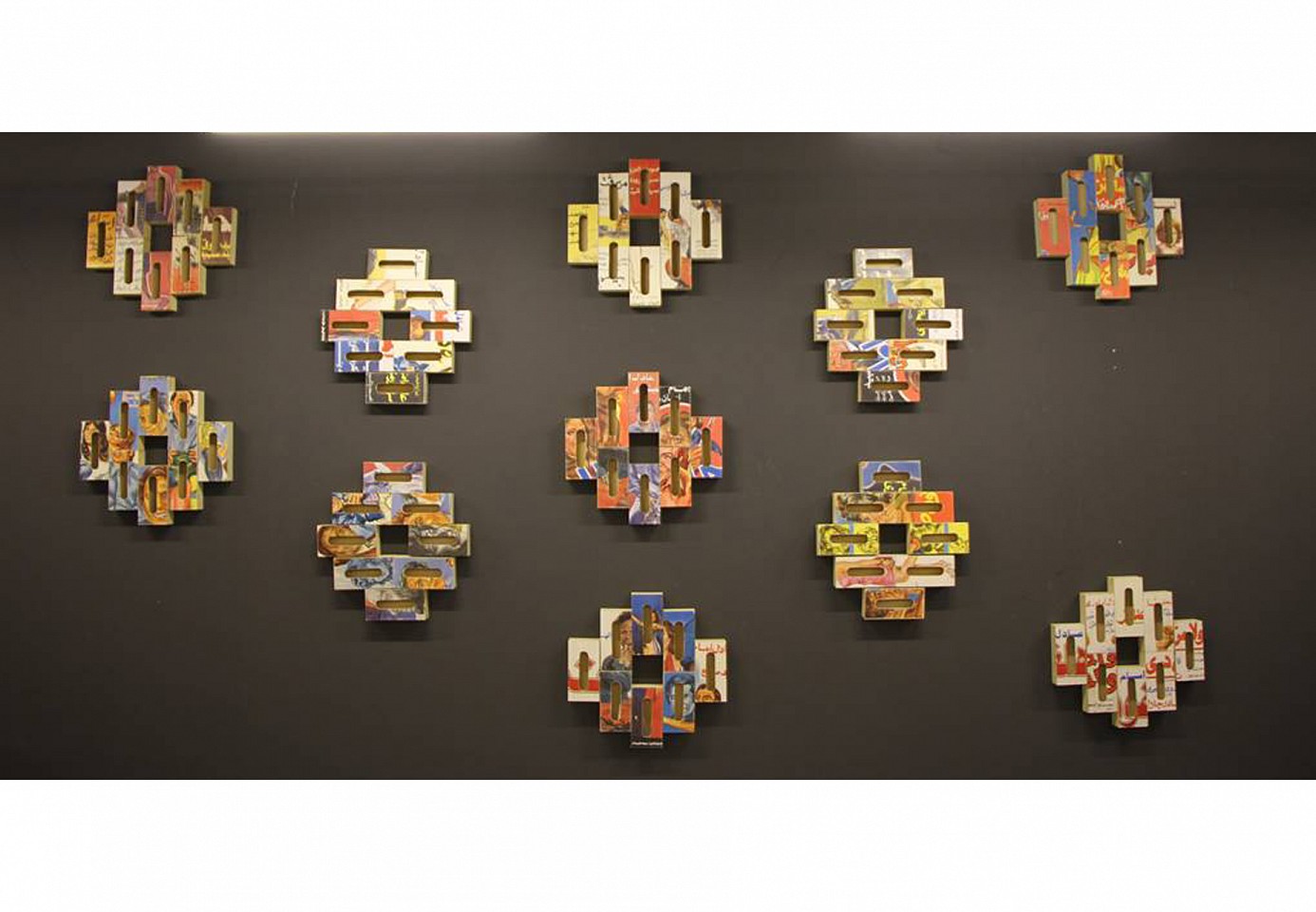Ayman Yossri Daydban
Untitled 1-8 from the Flower Series, 2016
8 film posters on tissue Boxes (each)
The series Maharem originated from the tissue box which middle to lower income families traditionally exhibit in their sitting room for their guests’ convenience. These boxes are usually lavishly decorated with velvet and kitsch gold rims and are often considered decorative masterpieces, a source of pride to the lady of the house. The artist physically manipulates the tissue box, ripping it bare of the comfort of the velvet coating. He then prints movie imagery onto the rough wood, overlaying the scenes and portraits with the direct language of popular sayings, proverbs and riddles.
Athr participates for the third time in The Armory with Hazem Harb, Poklong Anading, Ayman Yossri Daydban and Nasser Al-Salem.
The artists, whom hale from Palestine, Saudi Arabia and the Philippines, explore themes of eliminated and dismantled memories and identities within their work. The contrast between Poklong’s work Anonymity, in which his subjects’ identities are erased, and their background setting is highlighted, to the remaining artists’ work that revive archeological, architectural, cinematic and heritage through archives, symbols and imagery, are posed to suggest the necessity of persevering identity by re-imaging the surrounding landscapes of the human condition as time capsules of both the past and present.
Hazem Harb attempts to engage in dialogue the collective and individual memory of his people in his work The Everlasting Presence of an Excluded Memory. The work assembles 6 unique pieces interlinked in constructing the final work. The overlapping collage of authentic archives with 1932 Palestinian coins and pre-Nakba maps that date back to 1948 depict a storage or bank of underlying notions, symbols, issues and values that not only link, but assemble the Palestinian identity as a whole. The artist presents an analysis of this exclusion of memories, yet simultaneously highlighting its existence, questioning the absurdity of attempting to alter the contents of an everlasting memory and annihilating it, when its mere existence is everlasting.
Ayman Yossri Daydban’s Maharem are made of issue-boxes with fragments of film imagery – actors faces and shreds of titles, subtitles and names. The artist uses the language of fractured montage to reference the saturation of conflicting messaging we receive on a daily basis. Similar to a previous work entitled Love (2013), there is a visual harmony to the work when viewed from a distance, yet on closer inspection we are confronted with discord and uneasy interjections. The works presented in the Armory specifically reference Adil Imam, an icon in Arab cinema, and a representative of an era that witnessed both the rise and demise of Egypitian cinema along side the changing political, religious and social landscapes in the past 60 years of the Arab world
Poklong Anading’s Anonymity is comprised of photographic images displayed with an array of light-boxes. In creating the images, Poklong enlisted the participation of friends, acquaintances, and strangers to pose with a circular mirror held in front of their faces, reflecting the blinding glare of the sun directly towards the camera lens. The heads of these ‘subjects’ exploded in a corona of light, with their clothes, bearings, and background settings as the only legible markers of who they might be. The group or individuals thus appearing as a constellation of flashes. Hence, the work is an inversion of a photographic genre (portraiture) and an exploration for true photography, which is capturing light.
Nasser Al-Salem’s work City Nomads is a movingly nostalgic piece that is a drastic departure from the artist’s previous calligraphic work. The subject, one that is close to his heart, is of the nomadic traditions that are forcibly disappearing by the ever-expanding cities and fast-paced modernization. The work comprises of traditional tent flaps (that made-up the entrances of tents) marked with calligraphic verses and indications of modern-day ”tagging” that geo-records their location. The artist not only revives his family’s heritage of tent-making, but explores the visual language of the every changing urban symbols of the city.




